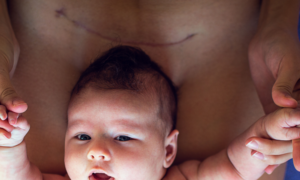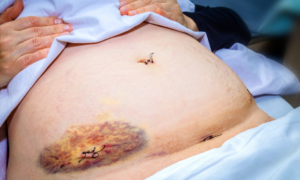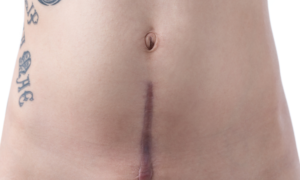Dealing with Bruising After a C Section: Tips and Causes to Consider
Bruising is a common side effect of undergoing a C-section, also known as a Cesarean delivery. A C Section is a surgical procedure in which a baby is delivered through an incision in the mother’s abdomen. While a C-section can save a mother and baby’s lives in certain circumstances, it is also a major surgery that requires recovery. One of the most common symptoms of this recovery time is bruising.
Bruising occurs when blood vessels break and blood leaks into the surrounding tissues, causing skin discoloration. This discoloration is a sign of internal injury, but it is usually not a cause for concern. In the case of a C-section, bruising can occur at the incision site and in other areas, such as the lower abdomen, legs, and arms.
The appearance of bruising can range from a light yellow or greenish color to a deep blue or purple. The extent of the bruising will depend on the individual and the procedure performed. Some women may experience a large amount of bruising, while others may have minimal discoloration. Bruising can also be accompanied by pain, swelling, and tenderness.
Understanding that bruising is a normal part of the recovery process after a C-section is essential. However, if the bruising is accompanied by other symptoms such as fever, difficulty breathing, or increased pain, it may be a sign of infection, and medical attention should be sought.
Taking care of the incision site is essential to minimize the risk of bruising after a C-section. This includes avoiding heavy lifting or strenuous activities, applying ice packs to the area, and keeping the incision site clean and dry. Women should also avoid alcohol, nicotine, and drugs that can slow healing.
Bruising is a common side effect of a C-section and is usually not a cause for concern. However, if accompanied by other symptoms, medical attention should be sought. Women can minimize the risk of bruising and promote a smooth recovery by taking care of the incision site and avoiding activities that can slow down the healing process.
Common Causes of Bruising After C-Section Delivery
Bruising is common after a c-section delivery, but it can cause discomfort and concern for new mothers. While some bruising is expected, a few common causes can contribute to more significant or persistent bruising. Understanding these causes can help women take steps to minimize their risk of bruising and recover more quickly after delivery.
Surgical Trauma
The incision used for a c-section delivery is a significant source of bruising. The incision typically runs vertically along the abdomen, and the skin and tissues in this area may be bruised due to the surgical procedure. Additionally, the skin may be pulled or stretched during the surgery, further contributing to bruising.
Blood Clotting Disorders
In some cases, bruising may persist for an extended period of time due to an underlying blood clotting disorder. Blood clotting disorders can increase the risk of bruising. Women with a family history of clotting disorders may be more likely to experience bruising after a c-section.
Blood Loss
Women who experience heavy bleeding during or after delivery may also experience more significant or persistent bruising. Blood loss can contribute to bruising by reducing the oxygen and nutrients available to the skin and tissues, making it more susceptible to injury and bruising.
Poor Healing
Women with a slow or poor healing process may also experience more significant or persistent bruising after a c-section. This can be due to age, obesity, poor nutrition, or underlying medical conditions.
Infection
In some cases, bruising may persist or worsen due to an infection at the incision site. Women who have an infection after delivery may experience redness, swelling, and warmth in the area, in addition to persistent bruising.
Bruising after a c-section delivery is a common occurrence that surgical trauma, blood clotting disorders, blood loss, poor healing, and infection can cause. Understanding these causes can help women take steps to minimize their risk of bruising and recover more quickly after delivery. Women who experience persistent or worsening bruising after a c-section delivery should speak to their doctor to rule out underlying health issues.
What to Expect in Terms of Bruising After a C-Section
Bruising is a common side effect of a C-Section. The incision site will appear red and swollen, which may turn into bruises of varying colors, such as black, blue, purple, and yellow. The bruises can last several weeks, but the severity and duration depend on the individual.
Pain and Discomfort: In addition to bruising, you may experience pain and discomfort in the incision site. This can be due to the pressure on the incision from movements, coughing, or sneezing. Pain can also be due to the muscles, nerves, and tissues being cut and moved during the procedure.
Swelling: Swelling is another common side effect of a C-Section. The swelling can occur due to fluid accumulation around the incision. This swelling can be reduced by elevating your legs and applying a cold compress to the affected area.
Infection: Bruising after a c-section can increase the risk of infection. If the incision is not properly cleaned, bacteria can enter the wound and cause an infection. Signs of infection include redness, swelling, and discharge from the wound.
Hematoma: Hematomas are blood pockets that form outside blood vessels and can occur after a c-section. They can be painful and may require surgical intervention to remove.
Seroma: A seroma is a collection of fluid that can form after a c-section. It can cause swelling and discomfort and may lead to infection if not treated properly.
Numbness: Some women may experience numbness or tingling in the affected area after a c-section. This is usually temporary, but in some cases, it may persist for longer.
Scarring: Bruising can increase the risk of scarring after a c-section. If the wound is not properly cared for, it can form scar tissue, which can be painful and unsightly.
Itching: Itching is also a common side effect of a C-Section. This can be due to the healing process and the skin stretching around the incision site. You can relieve the itching by applying a moisturizing lotion or cream to the affected area.
Redness: The incision site may appear red after a C-Section. This can be due to the increased blood flow to the area, which helps to speed up the healing process. The redness should fade within a few days, but you should consult your doctor if it persists.
Incision Bruising: The incision site is one of the most common places to experience bruising after a C-section. This is because the skin and tissue are cut during the procedure. The bruising can range from light to dark, depending on the individual and the severity of the incision.
Abdominal Bruising: Bruising can also occur in the abdominal area as a result of the surgery. The bruising is usually a result of the pressure applied to the area during the procedure. This bruising can be uncomfortable, but it is not typically dangerous.
Bruising on the Thighs: Some women may experience bruising on the thighs after a C-section. This is because the pressure applied to the legs during the procedure can cause bruising in the affected area.
Time to Heal: Bruising after a C-section can take several weeks to heal. The healing process will depend on the individual and the severity of the bruising.
Pain Management: Pain management is essential for reducing bruising and promoting healing after a C-section. Over-the-counter and prescription pain medications may be used to manage pain and discomfort.
Bruising after a C-section is common and should be expected. The bruising can range from light to dark and occur on the incision site, abdominal area, and thighs. The healing process can take several weeks, and pain management is essential for reducing bruising and promoting healing. You must speak with your doctor if you have any concerns about bruising after your C-section.
How to Minimize Bruising After a C-Section 
A C-section is a major surgical procedure involving an incision through the abdominal and uterine walls to deliver a baby. The procedure is usually safe and effective, but it can result in some discomfort and swelling. Bruising is a common side effect of a C-section and can last for a few weeks after delivery. However, there are steps you can take to minimize bruising and speed up the healing process. Here are some tips to help minimize bruising after a C-section:
Apply ice packs to the incision site: Applying an ice pack to the incision site can help reduce swelling and minimize bruising. Wrap a cold compress in a towel and place it on the incision site for 15-20 minutes, several times a day.
Elevate the incision site: Keeping the incision site elevated can help reduce swelling and minimize bruising. Use pillows to prop up the incision site while lying down or sitting up.
Avoid heavy lifting: Lifting heavy objects can increase pressure on the incision site, leading to more swelling and bruising. Avoid lifting heavy objects, such as babies and bags, for at least 2-3 weeks after a C-section.
Wear supportive clothing: Wearing supportive clothing, such as a compression garment, can help reduce swelling and minimize bruising. This clothing will help hold the incision site in place, reducing the risk of further injury.
Take over-the-counter pain medication: Over-the-counter pain medication, such as ibuprofen or acetaminophen, can help reduce swelling and minimize bruising. Follow the instructions on the label and speak with your doctor if you have any concerns about taking medication.
Get plenty of rest: Getting plenty of rest can help speed up the healing process and minimize swelling and bruising. Avoid overexerting yourself for the first few weeks after a C-section, and get plenty of sleep.
Keep the incision area clean: Maintaining good hygiene is crucial for healing the incision site after a c-section. Wash the area with soap and water, and avoid applying any creams or lotions.
Use a compression garment: Wearing a compression garment, such as a girdle, can help reduce swelling and minimize bruising.
Apply ice packs: Ice packs can help reduce swelling and minimize bruising. Apply an ice pack to the incision site for 20 minutes at a time, with a 20-minute break.
Get plenty of rest: Rest is crucial for healing after a c-section. Make sure to get plenty of rest and avoid strenuous activities for at least 4-6 weeks.
Avoid strenuous exercise: Strenuous exercise can increase the risk of bruising and slow the healing process. Avoid engaging in strenuous activities for at least 4-6 weeks after your c-section.
Massage the incision site: Massaging the incision site can help reduce swelling and minimize bruising. Gently massage the incision site with your fingers in a circular motion.
Drink plenty of water: Drinking plenty of water can help reduce swelling and minimize bruising. Make sure to drink at least 8 glasses of water per day.
Use a pillow: Sleeping with a pillow under your incision site can help reduce pressure and minimize bruising.
Consult with your doctor: If you are experiencing excessive bruising, pain, or swelling, be sure to consult with your doctor. Your doctor may prescribe additional medications or treatments to help minimize bruising and reduce discomfort.
Following these tips can minimize bruising and speed up the healing process after a C-section. It’s important to remember that every woman’s body heals differently, so the swelling and bruising may take some time to subside. If you experience severe pain or excessive bleeding, speak with your doctor immediately.
When to Seek Medical Attention for Bruising After C-Section
Bruising after a c-section is a common side effect of the surgery and can be painful and uncomfortable. While some bruising is normal and should fade over time, it is essential to know when to seek medical attention. This article will discuss some critical indicators that it may be time to seek medical attention for your bruising after a c-section.
- Persistent pain: If the bruising is accompanied by persistent pain not relieved by over-the-counter pain relievers, it may be a sign of a more serious issue.
- Severe swelling: If the bruising is accompanied by severe swelling that does not subside after a few days, this may be a sign of an infection or another underlying issue.
- Redness: If the bruising becomes red or shows signs of inflammation, it may indicate an infection or other underlying condition.
- Foul odor: A foul odor associated with the bruising may be a sign of an infection and should be evaluated by a medical professional immediately.
- Heat: If the area of the bruising feels warm to the touch, it may be a sign of an infection or other underlying issue and should be evaluated by a medical professional.
- Persistent bleeding: If the bruising continues to bleed or you notice any new bleeding, it is essential to seek medical attention immediately.
- Difficulty moving: If you experience difficulty moving or walking due to the pain or swelling associated with the bruising, it is essential to seek medical attention.
It is essential to seek medical attention if you experience any of the above symptoms, as they may indicate a more serious issue. Your healthcare provider can examine the area and provide appropriate treatment if necessary.
Some bruising after a c-section is normal. It is essential to seek medical attention if you experience persistent pain, severe swelling, redness, foul odor, heat, persistent bleeding, or difficulty moving. By seeking medical attention, you can ensure that your recovery is as smooth and comfortable as possible.
Understanding the Role of Pain Medication in Managing Bruising After C-Section
Childbirth is a life-changing experience for every woman, but it can also bring physical challenges, such as bruising. A c-section, also known as a caesarean section, is a surgical procedure in which a baby is delivered through incisions in the mother’s abdomen and uterus. After undergoing a c-section, a woman may experience pain, swelling, and bruising. Pain medication can help manage these symptoms and aid in healing. Here is a list of things to understand about the role of pain medication in managing bruising after a c-section:
Types of pain medication: Several types can be used after a c-section, including over-the-counter medications such as ibuprofen and acetaminophen and prescription painkillers like opioids.
Relief from pain: Pain medication is a crucial part of post-operative care for c-section patients. It helps to relieve pain and discomfort and allows the patient to move around more freely. This, in turn, can help to prevent further bruising and swelling.
Reducing inflammation: Pain medication can also help to reduce inflammation, which can cause pain, swelling, and bruising. Anti-inflammatory drugs, such as ibuprofen, can be particularly helpful in reducing these symptoms.
Precautions: It is important to take pain medication as directed by a healthcare provider. Overuse or misuse of pain medication can lead to side effects, such as nausea, dizziness, and drowsiness. Breastfeeding women should also be careful when taking pain medication, as it can be passed to the baby through breast milk.
Alternative therapies: In addition to pain medication, other alternative therapies can help to manage bruising after a c-section. Ice packs and compression garments can help to reduce swelling and promote healing. Massage and physical therapy can also be beneficial for reducing pain and promoting healing.
Pain medication is crucial in managing bruising after a c-section. Understanding the different types of pain medication, their benefits, and precautions can help women to make informed decisions about their post-operative care. As always, it is essential to consult a healthcare provider before starting any new medication or therapy.
Top 13 Home Remedies for Bruising After C-Section
Bruising after a c-section can be uncomfortable and unsightly. Fortunately, several home remedies can help to soothe the skin and reduce the appearance of bruises. Here are the top 13 home remedies for bruising after a c-section:
Ice: Applying an ice pack to the bruised area can help to reduce swelling and numb the pain. Wrap the ice pack in a towel before applying it to the skin to avoid damaging it.
Arnica is a natural remedy used for centuries to help reduce swelling and bruising. It is available in creams, gels, and ointments that can be applied directly to the skin.
Witch Hazel: Witch hazel is a natural astringent that can help to reduce swelling and improve circulation in the affected area. Apply witch hazel to a cotton ball and place it on the bruise.
Aloe Vera: Aloe vera is a natural moisturizer that can help to soothe the skin and reduce the appearance of bruises. Apply aloe vera gel directly to the affected area.
Vitamin K Cream: Vitamin K has been shown to help reduce bruising and improve healing. A Vitamin K cream can be applied directly to the skin.
Comfrey: Comfrey is a natural herb used for centuries to help reduce swelling and bruising. Apply a comfrey ointment or cream directly to the affected area.
Hot and Cold Therapy: Alternating between hot and cold compresses can help to reduce swelling and numb the pain. Apply a warm towel to the area for five minutes, then switch to a cold towel for five minutes. Repeat the process for 10-15 minutes.
Turmeric: Turmeric is a natural anti-inflammatory that can help to reduce swelling and improve circulation. Mix turmeric powder with water to paste and apply it to the affected area.
Essential Oils: Essential oils like lavender, chamomile, and tea tree oil can help to reduce swelling and soothe the skin. Mix a few drops of essential oil with a carrier oil like coconut oil and apply it directly to the affected area.
Horse Chestnut: Horse chestnut is a natural remedy to help reduce swelling and improve circulation. It is available in creams, gels, and ointments that can be applied directly to the skin.
Bromelain: Bromelain is a natural enzyme shown to help reduce swelling and improve the healing process. It is available in the form of supplements that can be taken orally.
Massage: Massaging the affected area can help to reduce swelling and improve circulation. Use your fingers to gently massage the affected area.
Hydration: Staying hydrated is essential for overall health and can help to reduce swelling and improve circulation. Drink plenty of water and avoid consuming too much salt or caffeine, which can contribute to swelling.
These home remedies can effectively reduce the appearance of bruises and improve the healing process. However, it is always best to consult your doctor if your bruises are severe or if you have any concerns about your recovery.
When to Expect Bruising to Subside After a C-Section
When a woman undergoes a cesarean section (C-section), it is common to experience bruising and swelling in the surgical area. This can be uncomfortable and affect a woman’s mobility, especially in the first few days after the surgery. Understanding when to expect the bruising to subside can help women prepare for recovery and make the necessary arrangements for themselves and their newborns. We will discuss when to expect the bruising to subside after a C-section.
One to two weeks after the surgery, The most significant amount of bruising and swelling can be expected to occur in the first week after the surgery. However, by the second week, most women will notice a significant improvement in their bruising and swelling.
Factors that affect the healing process The rate at which the bruising and swelling subside can be influenced by several factors, including the extent of the surgery, the woman’s health and recovery, and the type of incision used during the surgery. Women who experience complications during or after surgery may also experience a longer healing time.
Pain management Managing pain during recovery is essential to healing from a C-section. Over-the-counter pain medications such as ibuprofen or acetaminophen can help to relieve discomfort and reduce swelling. Women who experience excessive pain may need to consult their healthcare provider to discuss alternative pain management options.
Bruising and swelling may persist after two weeks, or the woman may experience other symptoms such as a fever, excessive bleeding, or difficulty urinating. If this occurs, seeking medical attention as soon as possible is essential to ensure a proper diagnosis and prompt treatment.
The Connection Between Bruising and C-Section Scarring
Subsiding of bruising and swelling after a C-section can be expected to occur within one to two weeks after the surgery. However, the healing process can be influenced by several factors and can vary from woman to woman. Pain management and seeking medical attention, if necessary, are crucial aspects of recovery.
Bruising and scarring are two common side effects that can occur after a surgical procedure, including a cesarean section (C-section). Many women who undergo a C-section experience some degree of bruising and scarring. While these side effects are typically not serious, they can be uncomfortable and unsightly, leading to questions about their cause and potential treatments.
Bruising occurs as a result of trauma to the skin and underlying tissues. When a person experiences a surgical procedure, the skin is usually incised, and the underlying tissues are manipulated. This can cause small blood vessels to rupture and bleed, leading to the formation of bruises. In the case of a C-section, bruising can occur at the site of the incision and in the surrounding areas. This can be particularly problematic for women with sensitive skin or prone to bruising.
Scarring is another common side effect of C-section procedures. Scarring occurs when the skin and underlying tissues attempt to heal after a surgical procedure. During the healing process, new tissue is produced to fill the wound. This new tissue, known as scar tissue, is not as strong or flexible as the original tissue and can form a permanent scar. In the case of C-sections, scarring can occur at the site of the incision as well as in the surrounding areas.
Several factors can impact the likelihood of bruising and scarring after a C-section procedure. These factors include age, genetics, overall health, and the type of incision used. Older women with a family history of scars or underlying health conditions may be more likely to experience bruising and scarring after a C-section procedure. Additionally, the type of incision used during a C-section can impact the likelihood of bruising and scarring. For example, incisions made using a scalpel are more likely to result in scarring than those made with a laser.
While bruising and scarring after a C-section procedure is not usually serious, they can be uncomfortable and unsightly. To reduce the risk of these side effects, women are encouraged to take steps to promote proper healing after their C-section procedure. This may include following a healthy diet, avoiding alcohol and tobacco, and reducing stress. In addition, women may also consider using topical creams or other products specifically designed to reduce the appearance of scars and bruises.
With proper care and attention, most women can successfully recover from a C-section procedure and minimize the impact of bruising and scarring.
Signs and Symptoms of Internal Bleeding After a C-Section Delivery
As a new mother, one of the most critical concerns you may have is your health after a c-section delivery. The surgical incision site may take some time to heal, and you may experience discomfort, but internal bleeding is a significant worry.
A c-section involves an incision in the abdominal area to deliver your baby. As a result, it’s essential to know the signs and symptoms of internal bleeding after a c-section.
Here are a few signs that you may be experiencing internal bleeding
Pain and discomfort in the incision site: If you experience increased pain and discomfort in the incision site, this may indicate internal bleeding. This is because the blood inside your body is collected in the incision area.
Abnormal vaginal bleeding: If you are experiencing heavy or prolonged vaginal bleeding, this may be a sign of internal bleeding. The incision site may not contain the amount of blood produced, causing it to escape through the vaginal area.
Low blood pressure: Internal bleeding can lead to a drop in blood pressure, causing you to feel dizzy or lightheaded. This can be a concerning sign, indicating significant internal bleeding.
Swelling or bloating: If you notice that your abdominal area is swelling or bloating, this may be an indication of internal bleeding. As the blood collects in your abdomen, it can cause the area to become distended.
Uneven breathing: If you are experiencing shortness of breath or rapid breathing, this may indicate internal bleeding. This is because the blood from inside your body is not circulating properly, causing difficulty breathing.
Seeking medical attention if you experience any of the above signs or symptoms is essential. Your doctor can diagnose and treat any internal bleeding, ensuring you recover from your c-section delivery without complications.
Internal bleeding after a c-section delivery is a significant concern for new mothers. Knowing the signs and symptoms of internal bleeding will help you identify when you need medical attention. You can ensure a quick and healthy recovery from your c-section delivery with proper care and treatment.
Frequently Asked Questions And Answers
What is a C-Section, and why is it performed?
A C-Section, also known as a cesarean delivery, is a surgical procedure in which a baby is delivered through incisions in the abdomen and uterus. It is performed when a vaginal delivery is unsafe for the mother or baby.
Is bruising common after a C-Section?
Yes, bruising after a C-Section is common and is usually a result of surgical incisions and pressure from the delivery.
How long does bruising after a C-Section last?
Bruising after a C-Section can last anywhere from a few days to a few weeks, depending on the individual.
Where can I expect to experience bruising after a C-Section?
Bruising after a C-Section is usually found in the lower abdomen and can also occur on the legs, arms, or hands.
Can I do anything to prevent bruising after a C-Section?
It is not possible to completely prevent bruising after a C-Section. Still, some things that can help reduce the risk include keeping the incision site clean, avoiding constricting clothing or activities, and following the doctor’s instructions for recovery.
Is bruising after a C-Section painful?
Bruising after a C-Section can be uncomfortable or painful, but this should subside within a few days to a few weeks.
Is there anything I can do to relieve the pain or discomfort caused by bruising after a C-Section?
Applying ice packs to the bruised area can help relieve pain and discomfort. Over-the-counter pain relievers and rest can also help.
Is it normal to experience swelling after a C-Section?
Yes, swelling is normal after a C-Section and is usually a result of fluid accumulation in the body.
Will the swelling and bruising go away on their own?
In most cases, the swelling and bruising will go away. However, if it persists or worsens, it is essential to consult a doctor.
Is it safe to wear tight clothing around the waist after a C-Section?
It is best to avoid wearing tight clothing around the waist after a C-Section as this can put pressure on the incision site and worsen bruising.
Can I bathe or shower after a C-Section?
It is safe to bathe or shower after a C-Section, but keeping the incision site clean and dry is essential.
When can I start exercising after a C-Section?
The timeline for starting exercise after a C-Section can vary, but it is essential to follow the doctor’s instructions and start slowly with light exercises before gradually increasing intensity.
When should I see a doctor about my bruising after a C-Section?
If the bruising is accompanied by a fever, increased pain, or signs of infection, it is essential to consult a doctor as soon as possible. A doctor should also be consulted if the bruising does not subside or worsen.







